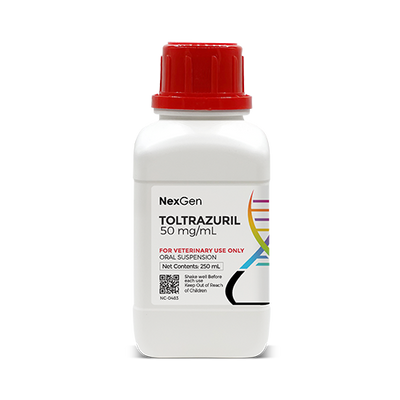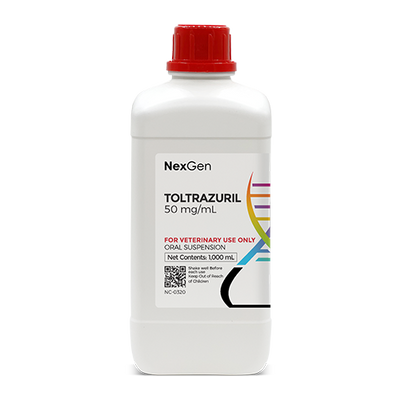
Toltrazuril 150 mg/mL + 10% DMSO, Oral Suspension, 250mL
Login for pricing
- Brand
- Mixlab
- SKU:
- NC-0318
- Product Type:
- Suspension
- Size:
- 250ml
- Administration:
- Oral
Equine protozoal myeloencephalitis (EPM) is a serious disorder of the nervous system of horses caused by the protozoan organism Sarcocystis neurona.1 It typically affects the brain and spinal cord. The disease is not transmitted from horse to horse; the protozoa are spread by the definitive host, the opossum, and horses that come in contact with infected opossum feces can develop EPM. Other hosts of S. neurona are believed to include armadillos, skunks and domestic cats. More than 50% of all horses in the US may have been exposed to S. neurona.
The infective stage of the organism (the sporocysts) is passed in the opossum's feces. The horse comes into contact with the infective sporocysts while grazing or eating contaminated feed or drinking water. Once ingested, the sporocysts migrate from the intestinal tract into the bloodstream and cross the blood/brain barrier. There they begin to attack the horse's central nervous system. The onset of the disease may be slow or sudden and, if left undiagnosed and untreated, EPM can cause lasting neurological damage.
The clinical signs of EPM can vary, and are usually asymmetrical (not the same on both sides of the horse). Symptoms can depend on the severity and location of the lesions that develop in the brain, brain stem or spinal cord.2 These may include:
- Incoordination
- Weakness, which may worsen when going up or down slopes
- Muscle atrophy along the topline or in the hindquarters
- Drooping eyes, ears or lips
- Difficulty swallowing
- Seizures or collapse
- Abnormal sweating
- Loss of feeling along the face, neck or body
- Head tilt with poor balance
- Splay-footed stance, leaning
Diagnosis of EPM can be difficult to make, as there is no specific assay for it and because clinical signs of EPM can mimic other neurological diseases. Veterinarians typically conduct a thorough physical examination of the horse and may conduct blood and cerebrospinal fluid (CSF) analysis.
Toltrazuril + DMSO for the Treatment of EPM in Horses
Toltrazuril has only recently been used to treat EPM and coccidiosis in horses.1 Toltrazuril works by damaging the intracellular developmental stages of coccidia without damaging the cell tissue of the host animal. It is also used as a prophylaxis to prevent coccidia in horses.
Toltrazuril should not be used in patients who have had prior hypersensitivity reactions to it or other triazinone antiprotozoals (e.g., ponazuril, diclazuril).
Dimethyl Sulfoxide (DMSO) is classified as a nonsteroidal anti-inflammatory drug (NSAID) that has antioxidant properties that can interrupt the inflammatory process. It is used to treat a variety of equine health problems ranging from orthopedic inflammation to neurological injury.
DMSO traps free radical hydroxide, and its metabolite (dimethyl sulfide) traps free radical oxygen. These actions may help to explain some of the anti-inflammatory, cryopreservative, anti-ischemic, and radioprotective qualities of DMSO.
Where to buy Toltrazuril + DMSO
Toltrazuril + DMSO is available in the U.S. through pharmaceutical manufacturers and through veterinary custom compounding companies.
FOR RX ONLY: A valid prescription from a licensed veterinarian is required for dispensing this medication.
1Furr, M.O., et. al. A 10-day toxicity study of toltrazuril 5% suspension in the horse. Vet Ther. 2000 Fall;1(4):245-51. PMID: 19757571.




















